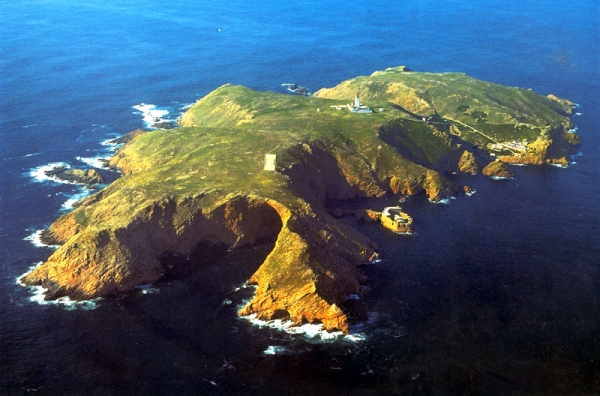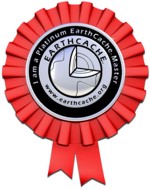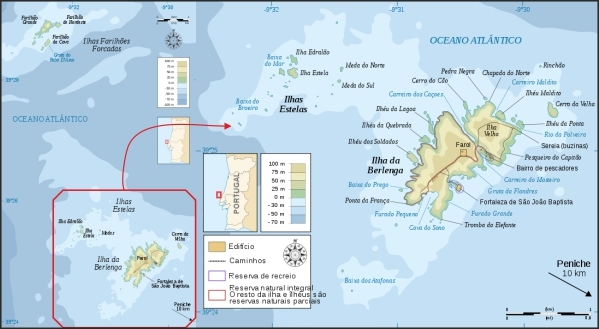
Orthoclase
Orthoclase (endmember formula KAlSi3O8) is an important tectosilicate mineral which forms igneous rock. The name is from the Greek for "straight fracture," because its two cleavage planes are at right angles to each other. Alternate names are alkali feldspar and potassium feldspar.
Orthoclase is a common constituent of most granites and other felsic igneous rocks and often forms huge crystals and masses in pegmatite.
Typically, the pure potassium endmember of orthoclase forms a solid solution with albite, the sodium endmember (NaAlSi3O8). While slowly cooling within the earth, sodium-rich albite lamellae form by exsolution, enriching the remaining orthoclase with potassium. The resulting intergrowth of the two feldspars is called perthite.
The higher-temperature polymorph of orthoclase is sanidine. Sanidine is common in rapidly cooled volcanic rocks such as obsidian and felsic pyroclastic rocks, and is notably found in trachytes of the Drachenfels, Germany. The lower-temperature polymorph of orthoclase is microcline. Adularia (from Adular) is found in low temperature hydrothermal deposits. The largest documented single crystal of othoclase was found in Ural mountains, Russia. It measured ~10x10x0.4 m3 and weighed ~100 tons. (Source: Here)
The Berlengas Archipelago
The Berlengas archipelago is a group of small islands 10 to 15 kilometers off the Portuguese coast, west of the town of Peniche. (Source: Here).
History - Human occupation on Berlenga Grande (the only habitable island) dates back to antiquity, when the islands was known as Λονδοβρίς (Londobris). Much later it was referred to as the island of Saturno by Roman geographers, and was visited successively by Muslims, Vikings and pirates/privateers from England and France.
In 1513, with the support of Queen Leonor, monks from the Order of São Jerónimo established a settlement on the island to offer assistance to navigation and victims of frequent shipwrecks. The monastery founded there (Monastery of Misericórdia da Berlenga), remained until the 16th century the when disease, lack of communication (due to inclement weather) and constant assaults by pirates and privateers from England and France, forced the monks abandon the service on the island.
During the Portuguese Restoration War, in the reign of King John IV, the Counsel of War determined the demolition of the monastery ruins, and the use of their rocks to build a coastal defense. By 1655 it had already, during its construction, it was able to resist an assault by three Barbary coast pirates.
The island's lighthouse, dubbed Duke of Braganza by locals, was constructed in 1841. In the 20th century a solar panel was installed in the lighthouse's 29 meter column, providing a 50 kilometer field of vision. Nowadays, the archipelago has no permanent population. (Source: Here).

Claiming a find in this EC:
At ground zero,
1- Tell me how large are the orthoclase crystals (the pink ones) in the outcrop in front of you.
2- Are the orthoclase (pink) crystals larger or smaller than the white (quartz) crystals?
3- In the outcrop in front of you, what is your perception of which crystals predominate? Orthoclase or quartz?
(To answer these questions you DO NOT need to get off the path).
After you have worked out the answers, please log your find but send me, through my profile, the answer (*). If it is correct, you will not hear from me again but know that I truly appreciate you taking the time to visit this island and I hope that you have learnt a little bit more about the geological processes that take place on the surface of the earth. If it's wrong I will send you an explanatory note showing you where you went wrong. If you don’t send the answer, your log will be deleted without any explanation.
(*) Please note that when you e-mail me, please supply the reference of the cache (GC2XP0Y) and name (e.g. Pretty in pink - DP/EC-59) of the cache and please click on the “I want to send my e-mail address along with this message” so that when I reply to you the messages don’t go into e-mail heaven (or hell).



Evolução geológica das Berlengas
O arquipélago das Berlengas, constituído Reserva Natural, situa-se aproximadamente a 15 km de Peniche e inclui três grupos de ilhéus: Berlenga Grande, Estelas e Farilhões. A Berlenga Grande ocupa 2/3 da superfície do arquipélago, sendo a única ilha habitada. Em termos litológicos a Berlenga Grande e as Estelas são constituídas basicamente por granitos porfiróides róseos, enquanto os Farilhões são constituídos por rochas metamórficas, nomeadamente, gnaisses e xistos.

Durante o período compreendido entre os 220 e os 140 Ma, dá-se a abertura da Bacia Lusitânica associada à evolução do Oceano Atlântico. Nesse momento houve o levantamento do horst da Berlenga devido à distensão da crusta terrestre adelgaçada pela instalação de uma pluma de magma oriunda do interior da Terra, nas fases precoces de abertura do Atlântico Norte. Foi nesse contexto que a formação das Berlengas teve início. A fragmentação da Pangea deu origem ao afastamento da América do Norte em relação à Península Ibérica, o qual afectou as Berlengas, localizadas na margem continental. A ilha da Berlenga é constituída por granitos porfiróides (com cristais de grandes dimensões e de forma bem definida no seio de uma matriz mais fina de feldspato de cor rosada, quartzo e biotite), resultantes de magma que arrefeceu em profundidade. Já os Farilhões, constituídos por gnaisses e xistos, resultam de pressões e esforços tectónicos que actuaram nas rochas. O afloramento destes materiais rochosos, de origem muito antiga, desencadeou a intensa fracturação estabelecendo-se uma rede de falhas NNW-SSE e WNW-ESE. A alteração química dos granitos intensificou-se ao longo das antigas falhas, gerando grutas e túneis, dando a estas ilhas a forma tão particular que hoje as caracteriza (Fonte: Aqui).
Para logarem esta EC:
No ponto zero,
1- No afloramento à tua frente, diz-me qual o tamanho dos cristais de ortoclase (os rosa).
2- Os cristais de ortoclase (rosa) são maiores ou menores do que os cristais brancos (de quartzo)?
3- No afloramento à tua frente, qual é a percepção dos cristais que predominam? Ortoclase ou quartzo?
(Para responder a essas perguntas, NÃO precisas de sair do caminho).
Esta respostas valem um "found it" se estiverem correctas. Se achas que acertaste na resposta, faz o teu log mas envia-me a resposta para o meu mail com a identificação da cache (nome ou código GC) e quando o fizeres escolhe a opção “I want to send my e-mail address along with this message”. Obrigado.

 The most exciting way to learn about the Earth and its processes is to get into the outdoors and experience it first-hand. Visiting an Earthcache is a great outdoor activity the whole family can enjoy. An Earthcache is a special place that people can visit to learn about a unique geoscience feature or aspect of our Earth. Earthcaches include a set of educational notes and the details about where to find the location (latitude and longitude). Visitors to Earthcaches can see how our planet has been shaped by geological processes, how we manage the resources and how scientists gather evidence to learn about the Earth. To find out more click HERE.
The most exciting way to learn about the Earth and its processes is to get into the outdoors and experience it first-hand. Visiting an Earthcache is a great outdoor activity the whole family can enjoy. An Earthcache is a special place that people can visit to learn about a unique geoscience feature or aspect of our Earth. Earthcaches include a set of educational notes and the details about where to find the location (latitude and longitude). Visitors to Earthcaches can see how our planet has been shaped by geological processes, how we manage the resources and how scientists gather evidence to learn about the Earth. To find out more click HERE.